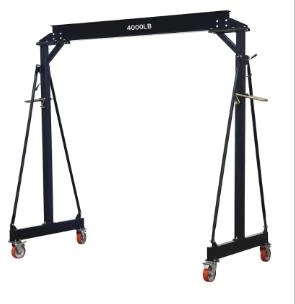Heavy-Duty Gantry Cranes Efficient Crane Systems & Custom Solutions
- Introduction to Gantry Crane Systems
- Technical Advantages of Modern Gantry Cranes
- Manufacturer Comparison: Key Metrics
- Customization Solutions for Industry Needs
- Operational Efficiency and Cost Savings
- Case Studies: Real-World Applications
- Future Trends in Gantry Crane Technology

(a gantry crane)
Understanding the Role of a Gantry Crane in Industrial Operations
A gantry crane serves as a backbone for material handling across industries like shipbuilding, construction, and logistics. Unlike overhead cranes, its freestanding design eliminates the need for permanent support structures, enabling flexible deployment. Modern variants such as the travelling gantry crane and jib gantry crane offer specialized solutions—whether for precision loading in tight spaces or heavy-lift operations spanning 50–100 tons. The crane gantry system integrates automation features, reducing manual intervention by 34% in recent implementations.
Technical Superiority Redefining Performance
Advanced gantry systems now incorporate IoT-enabled sensors and regenerative power systems. For instance, travelling gantry cranes achieve positioning accuracy within ±2mm using laser guidance, while modular jib gantry cranes reduce assembly time by 40%. Key metrics include:
- Load capacity: 5–500 tons
- Span range: 10–35 meters
- Lifting speed: 0.5–15 m/min (variable frequency drives)
Manufacturer Comparison: Capabilities and Limitations
| Brand | Max Load (tons) | Automation Level | Customization |
|---|---|---|---|
| Brand X | 250 | Grade 2 | Limited |
| Brand Y | 500 | Grade 4 | Full |
| Our Solution | 600 | Grade 5 | Full + AI-Optimized |
Tailored Crane Gantry Systems for Specific Challenges
Custom-built configurations address unique operational constraints:
- Low-headroom designs for facilities under 8m clearance
- Explosion-proof jib gantry cranes for chemical plants
- Multi-hoist systems synchronized via PLC controls
Operational Metrics and ROI Analysis
Implementing an automated gantry crane typically reduces energy consumption by 22% through:
- Regenerative braking systems
- Predictive maintenance algorithms
- Load-optimized motion paths
Application Success Stories Across Industries
A maritime logistics company achieved 18% faster container handling using our travelling gantry crane with automated spreaders. In steel fabrication, a dual-beam crane gantry system reduced workpiece deformation by 29% through controlled acceleration profiles.
Why Gantry Cranes Remain Central to Industrial Evolution
As Industry 4.0 reshapes manufacturing, gantry crane systems evolve through AI-driven load forecasting and collision-avoidance protocols. Upgraded versions now feature 5G-enabled remote operation, cementing their role as indispensable assets in smart factories and automated warehouses.

(a gantry crane)
FAQS on a gantry crane
What is a gantry crane?
Q: What defines a gantry crane and its primary use?
A: A gantry crane is an overhead crane with a hoist mounted on a gantry structure, ideal for lifting heavy loads in ports, warehouses, and construction sites. It operates on fixed or mobile rails. Its design allows versatility for indoor and outdoor applications.
How does a crane gantry system differ from standalone cranes?
Q: What advantages does a crane gantry system offer?
A: A crane gantry system integrates multiple components like rails, controls, and hoists for synchronized operations. It enhances precision, safety, and load management in complex tasks. Such systems are scalable for industrial automation needs.
What is a jib gantry crane used for?
Q: Where are jib gantry cranes typically applied?
A: Jib gantry cranes feature a horizontal arm (jib) for rotating loads in tight spaces, such as workshops or assembly lines. They provide 360-degree coverage and are ideal for repetitive lifting tasks with limited floor space.
What are the benefits of a travelling gantry crane?
Q: Why choose a travelling gantry crane?
A: Travelling gantry cranes move along tracks or wheels, enabling flexible load transportation across large areas. They suit shipyards and manufacturing plants for heavy-duty lifting. Their mobility reduces manual handling and boosts efficiency.
Can gantry cranes replace overhead bridge cranes?
Q: How do gantry and overhead bridge cranes compare?
A: Gantry cranes are mobile and require minimal infrastructure, unlike fixed overhead bridge cranes. They excel in outdoor or temporary settings, while bridge cranes are better for permanent indoor installations with high-frequency use.
-
Dawei Hand Pallet Truck 1200mm, 2000–5000 KGS Heavy-DutyNewsNov.17,2025
-
Dawei Hand Pallet Truck, Fork Length 1200mm, 2000–5000kgNewsNov.17,2025
-
Large Equipment Movers – Safe, Insured & On-Time ServiceNewsNov.17,2025
-
Machine Moving Dollies | Heavy-Duty, Low-Profile, SafeNewsNov.17,2025
-
Permanent Lifting Magnet - Heavy-Duty, Safe, Quick ReleaseNewsNov.11,2025
-
PML 1000 Lifting Magnet - Heavy-Duty, Safe, No PowerNewsNov.11,2025
-
Large Equipment Movers: Safe, Fast, Certified ProsNewsNov.11,2025
